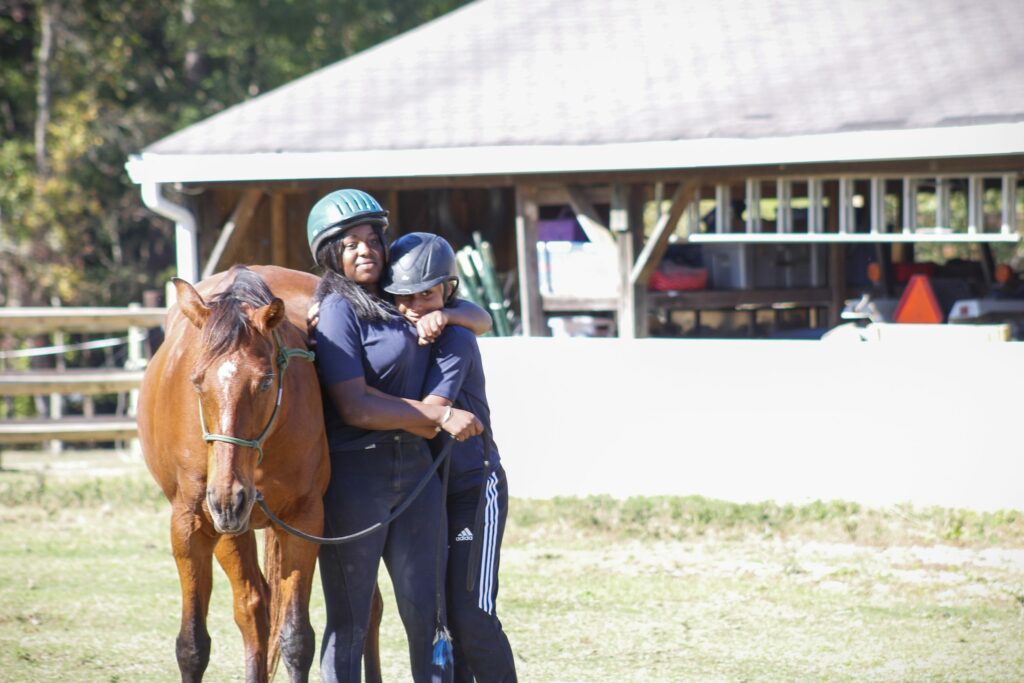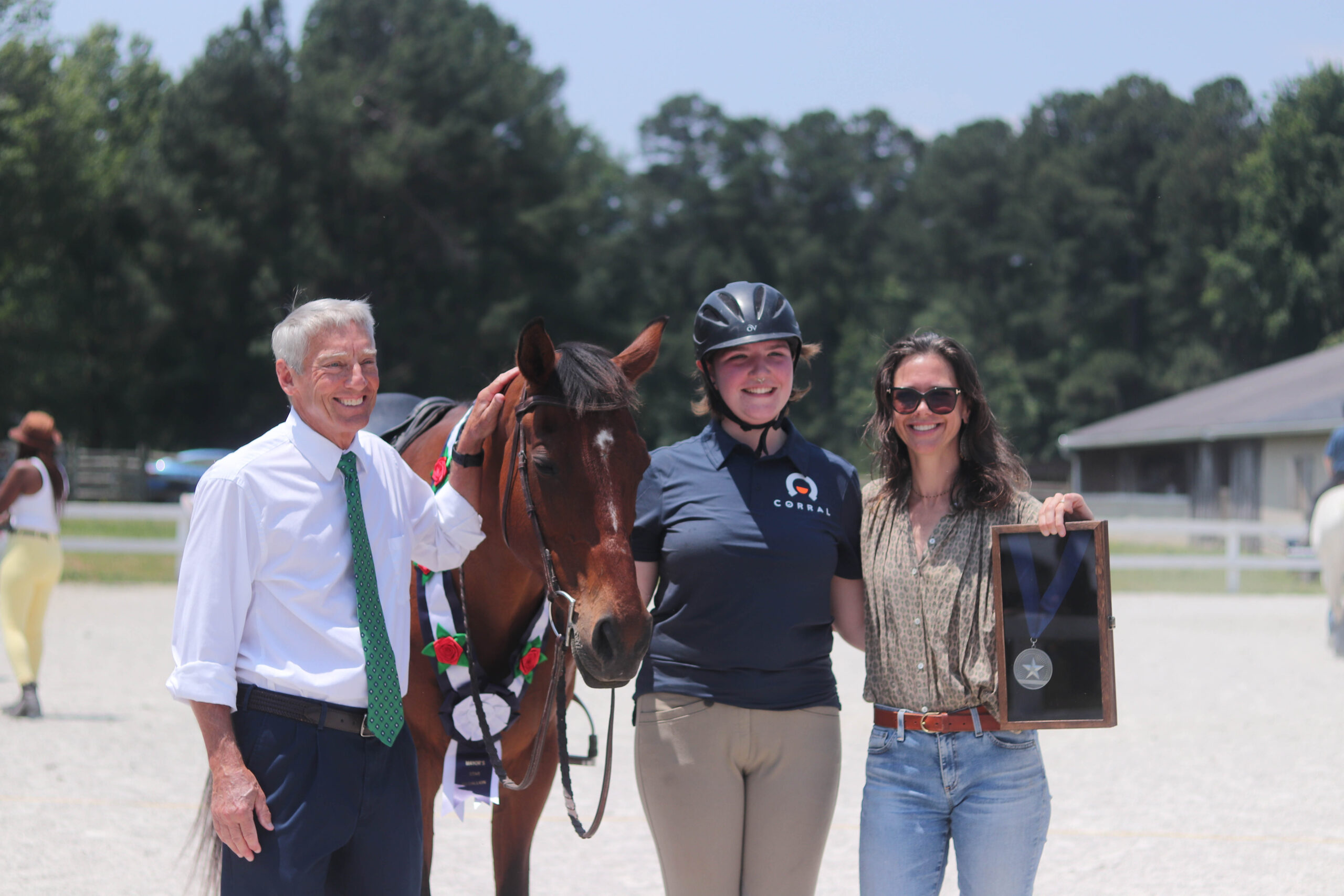Please note: This photo was taken pre-pandemic.
Kristy Bastone-Baker is one of CORRAL’s fall mental health interns. She has a Master’s degree in Conflict Resolution and is currently working on a second Master’s in Counseling. In addition, she’s a U.S. military veteran, wife, mother, and graduate student.
Tragically, the Centers for Disease Control and Prevention (CDC) lists suicide as the second leading cause of death for adolescents and young adults age 15-34 in the U.S. and the third leading cause for children age 10-14. Furthermore, Wake County reports that, on average, two students die each year by suicide.
Teen Suicide Risk Factors
According to the Child Mind Institute, teen suicide risk factors include:
- A recent or serious loss. This could include the death or illness of a loved one or a pet, the divorce or separation of parents, breakup of a friendship or romantic relationship, a parent losing a job, or the family losing their home.
- Mental health issues, particularly a mood disorder like depression or a trauma– and stress-related disorder.
- Prior suicide attempts.
- Alcohol and other substance use disorders, as well as getting into a lot of trouble, having disciplinary problems, engaging in a lot of high-risk behaviors.
- Struggling with sexual identity in an environment that is not respectful or accepting of that identity. The issue is not whether a child is LGBTQ, but whether they are struggling to come out in an unsupportive environment.
- A family history of suicide, domestic violence, child abuse or neglect.
- Lack of social support. A child who doesn’t feel support from significant adults in their life, as well as their friends, can become so isolated that suicide seems to present the only way out of their problems.
- Bullying. Not only is being a victim of bullying a risk factor, but there’s also some evidence that kids who are bullies may be at increased risk for suicidal behavior.
- Access to lethal means, like firearms and pills.
- Stigma surrounding asking for help. Also, if they feel a lot of guilt or shame, or if they feel worthless or have low self-esteem.
- Barriers to accessing services: Difficulties in getting much-needed services include lack of reliable transportation, bilingual service providers, and the financial cost of services.
- Cultural and religious beliefs that see suicide as a noble way to resolve a personal dilemma.
Marginalized Populations at Higher Risk for Suicide
Marginalized populations are at a higher risk for suicide, including people of color and members of the LGBTQIA community. Several studies have shown that youth of color, particularly Black youth, are at increased risk for suicide. Females are generally more likely than males to attempt suicide (though males are usually more likely to complete suicide).
COVID-19
The COVID-19 pandemic is also increasing the risks of suicide, particularly for young adults. Families are experiencing job losses, changes in living conditions, and financial and emotional stress. Rates of violence within the home are increasing. Loved ones are getting sick and dying from coronavirus itself. People of color are more likely to contract and die from COVID-19. Students are experiencing more isolation and falling behind in school as their education transitions online. All of these factors contribute to increasing depression, aggression, stress, turmoil, isolation, and a sense of loss–and therefore an increased risk of suicide.
Self-Harm
In 2019, Harris, Bees, and Moore conducted a study where they found that suicide in adolescents and young adults is commonly preceded by self-harm. 80% of girls at CORRAL have engaged in past self harm and risky behaviors.
Protective Factors of Teen Suicide
The Child Mind Institute lists some key protective factors of teen suicide as:
- Good problem-solving abilities. Teens who are able to identify a problem and figure out effective ways to manage it, to resolve conflicts in non-violent ways, are at lower risk.
- Strong connections. The stronger the connections kids have to their families, to their friends, and to people in the community, the less likely they are to harm themselves. Partly, that’s because they feel loved and supported, and partly because they have people to turn to when they’re struggling and feel really challenged.
- Restricted access to highly lethal means of suicide.
- Cultural and religious beliefs that discourage suicide and that support self-preservation.
- Relatively easy access to appropriate clinical intervention, whether that be psychotherapy, individual, group, family therapy, or medication if indicated.
- Effective care for mental, physical, and substance use disorders. Good medical and mental health care involves ongoing relationships, making kids feel connected to professionals who take care of them and are available to them.
CORRAL’s Work in the 2020 School Year
At CORRAL, most of the girls we serve are referred to us by the juvenile justice system. Even before the COVID-19 pandemic, they have experienced many of the suicide risk factors listed above. COVID-19 is compounding these effects and raising the pressure on already marginalized populations.
Our program seeks to combat suicide ideation by taking a multifaceted approach. We work with families, building on family strengths and helping to support students and their caregivers. In response to the COVID-19 pandemic, CORRAL has shifted away from our traditional after-school programming.
The girls are now coming to CORRAL during their school hours. There, they attend their live classes online, in a socially distanced environment. Their school performance is closely monitored and course corrected as needed. The girls also have chores they are required to complete during the day, which often involve helping to take care of the farm’s horses. They receive tutoring and academic counseling. They also engage in weekly individual and group Equine Assisted Psychotherapy. This helps reduce the girls’ sense of isolation and increases their sense of accountability and being part of a herd. The girls also learn to reach out to others and ask for help when they need it. This helps the girls build a sense of community, trust, and pride within themselves. CORRAL is committed to reducing teen suicide, even as we navigate these uncertain times and the COVID-19 pandemic.
For more information on how you can help CORRAL, please see here.
For more resources and information on suicide, please see the APA’s suicide help website.





